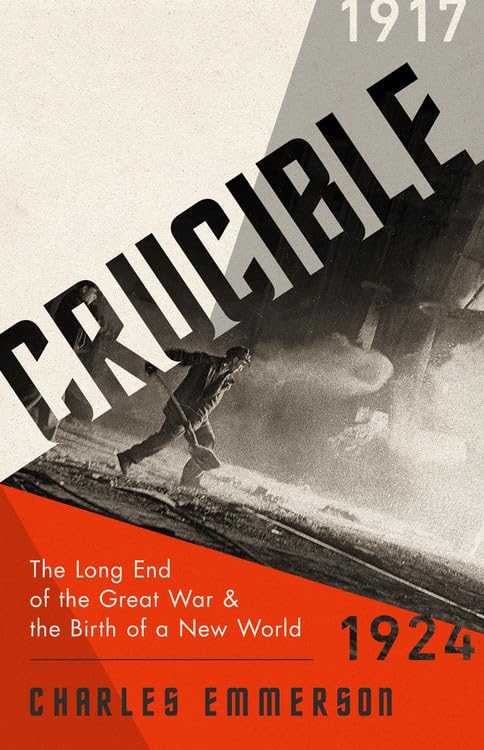Crucible: The Long End of the Great War and the Birth of a New World, 1917-1924, written by Charles Emmerson and published in 2019, is not just another historical account of the post-World War I era. Instead, it’s a deeply immersive and intensely relevant exploration of a period that continues to shape our world today. Emmerson, a historian with a background in both academia and international relations, brings a unique lens to this tumultuous period, moving beyond simple chronological storytelling. He masterfully weaves together political, social, and economic threads, revealing the complex forces that birthed the modern world. The book’s significance lies in its ability to illuminate the origins of many contemporary challenges, from geopolitical tensions to the rise of populism, making it incredibly pertinent to our current times.
Setting the Stage: A World in Flux
Emmerson’s narrative picks up where many World War I accounts leave off, diving headfirst into the chaotic aftermath of the armistice. The war’s end didn’t usher in peace; instead, it created a crucible of competing ideologies, shattered empires, and widespread social upheaval. Crucible doesn’t just list events; it transports you to the streets of post-war Berlin, the conference halls of Versailles, and the burgeoning cities of the Middle East. The atmosphere is one of both despair and hope, a sense that the old order had collapsed, and a new one was struggling to be born. This makes the book feel alive, and the world Emmerson recreates palpable.
Characters and Transformations
While not a novel with fictional characters, Crucible presents a cast of historical figures who are just as compelling. From Woodrow Wilson, the idealistic yet flawed American president, to Vladimir Lenin, the ruthless revolutionary, Emmerson paints portraits that are both nuanced and insightful. These individuals are not static figures in a history book, but complex actors with their own ambitions, fears, and flaws. We see how their decisions, both big and small, impacted the course of history, creating a deep understanding of their motivations. The book also looks at the collective characters of nations, revealing their shifts in national identity during this era. The focus on human agency adds another layer of depth to the narrative.
Themes and Emotional Impact
The central themes of Crucible revolve around the dangers of unchecked nationalism, the fragility of peace, and the enduring consequences of war. Emmerson doesn’t shy away from exploring the darker aspects of this period, including the rise of fascism and the brutal realities of colonialism. Find it on Amazon. The emotional resonance of the book lies in its ability to make you feel the weight of history, to understand how decisions made a century ago continue to shape our present. I was particularly struck by how easily the seeds of future conflicts were sown in the chaos of the post-war period, a chilling reminder of our own times. It made me reflect on how our present actions will shape future generations.
Content and Practical Application
Crucible offers a robust overview of the major political, economic, and social events of the period, but it goes beyond just a factual account. It analyzes the underlying forces that shaped those events, providing a coherent framework for understanding the complexities of the time. The book is meticulously researched, drawing on a wide range of primary and secondary sources. Emmerson’s analysis is sharp and his interpretations are thought-provoking. He avoids simplistic explanations, instead presenting a nuanced picture of the forces at play. This makes the book not just a historical record, but a tool for understanding the world.
While not a “how-to” manual, Crucible provides crucial lessons for navigating the present day. Understanding how the decisions made in the wake of World War I continue to impact global politics and economics can inform how we approach contemporary challenges. The book demonstrates the importance of international cooperation and the dangers of unchecked nationalism, which resonates powerfully in today’s political landscape. Check the price here. It is a reminder that history is not just a sequence of events, but a source of valuable lessons.
Writing Style and Narrative Techniques
Emmerson’s writing is clear, engaging, and accessible, even when dealing with complex historical topics. He has a talent for bringing history to life, making it feel immediate and relevant. He avoids jargon and academic dryness, instead opting for a conversational tone that keeps the reader engaged. The pacing of the book is excellent, moving seamlessly between different regions and events, and the author skillfully weaves together different narratives to create a cohesive whole. The author’s voice is authoritative but not overwhelming. He guides the reader through the complexities of this period without ever losing sight of the human stories at the heart of it all.
Conclusion: A Lasting Impact
Crucible is more than just a history book; it is an essential guide to understanding the modern world. It forces us to confront the enduring legacies of World War I and to recognize how the choices made a century ago continue to shape our present. The book’s power lies in its ability to make the past feel present, highlighting the timeless themes of human ambition, conflict, and the search for a better future. Get your copy on Amazon. I would highly recommend Crucible to anyone interested in history, international relations, or the forces shaping our contemporary world. It’s a book that will leave a lasting impact, prompting reflection and providing valuable insights into the challenges we face today.
Readers who enjoyed this book might also find themselves drawn to Margaret MacMillan’s “Paris 1919: Six Months That Changed the World”, another detailed look at the post-WWI era or “The Guns of August” by Barbara W. Tuchman, which covers the start of WWI. These books share a similar focus on the complex historical events that continue to shape our world, making them excellent choices for anyone looking to expand their understanding of this crucial period.

